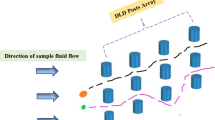Abstract
Blood flow in microcirculation shows several interesting phenomena that can be used to develop microfluidic devices for blood separation and analysis in continuous flow. In this study we present a novel continuous microfluidic device for partial extraction of red blood cells (RBCs) and subsequent measurement of RBC deformability. For this purpose, we use polydimethylsiloxane (PDMS) microchannels having different constrictions (25%, 50% and 75%) to investigate their effect on the cell-free layer (CFL) thickness and separation efficiency. By using a combination of image analysis techniques we are able to automatically measure the CFL width before and after an artificial constriction. The results suggest that the CFL width increases with enhancement of the constriction and contributes to partial cell separation. The subsequent measurements of RBCs deformation index reveal that the degree of deformation depends on the constriction geometries and hematocrit after the cell separation module. The proposed microfluidic device can be easily transformed into a simple, inexpensive and convenient clinical tool able to perform both RBC separation and deformability analysis in one single device. This would eliminate the need for external sample handling and thus reducing associated labor costs and potential human errors.
Similar content being viewed by others
References
Caro, C., Pedley, T., Schroter, R. & Seed, W. The Mechanics of the Circulation. Oxford University Press, 1978.
Lima, R. et al. Measurement of individual red blood cell motions under high hematocrit conditions using a confocal micro-PTV system. Ann. Biomed. Eng. 37, 1546–1559 (2009).
Fujiwara, H. et al. Red blood cell motions in highhematocrit blood flowing through a stenosed microchannel. J. Biomech. 42, 838–843 (2009).
Lima, R. et al. Axisymmetric polydimethysiloxane microchannels for in vitro hemodynamic studies. Biofabrication 1, 1–7 (2009).
Goldsmith, H. & Spain, S. Margination of leukocytes in blood flow through small tubes. Microvasc. Res. 27, 204–222 (1984).
Yang, S., Undar, A. & Zahn, J.D. A microfluidic device for continuous, real time blood plasma separation. Lab Chip 6, 871 (2006).
Shevkoplyas, S.S., Yoshida, T., Munn, L.L. & Bitensky, M.W. Biomimetic Autoseparation of Leukocytes from Whole Blood in a Microfluidic Device. Anal. Chem. 77, 933–937 (2005).
Hou, H.W. et al. Deformability based cell margination — A simple microfluidic design for malaria-infected erythrocyte separation. Lab Chip 10, 2605–2613 (2010).
Fujiwara, H. et al. Red blood cell motions in highhematocrit blood flowing through a stenosed microchannel. J. Biomech. 42, 838–843 (2009).
Ishikawa, T. et al. Asymmetry of blood flow and cancer cell adhesion in a microchannel with symmetric bifurcation and confluence. Biomed. Microdevices 13, 159 (2011).
Leble, V. et al. Asymmetry of red blood cell motions in a microchannel with a diverging and converging bifurcation. Biomicrofluidics 5, 044120 (2011).
Faivre, M., Abkarian, M., Bickraj, K. & Stone, H. Geometrical focusing of cells in a microfluidic device: an approach to separate blood plasma. Biorheology 43, 147–159 (2006).
Sollier, E., Cubizolles, M., Fouillet, Y. & Achard, J. Fast and continuous plasma extraction from whole human blood based on expanding cell-free layer devices. Biomed. Microdevices 12, 485–497 (2010).
Mokken, F.C., Kedaria, M., Henny, C.P., Hardeman, M.R. & Gelb, A.W. The clinical importance of erythtrocyte deformability, a hemorrheological parameter. Ann. Hematol. 64, 113–122 (1992).
Musielak, M. Red blood cell deformability measurement: Review of techniques. Clin. Hemorheol. Micro. 42, 47–64 (2009).
Shiga, T., Maeda, N. & Kon, K. Erythrocyte rheology. Crit. Rev. Oncol. Hemat. 10, 9–48 (1990).
Zhao, R. et al. Microscopic investigation of erythrocyte deformation dynamics. Biorheology 43, 747–765 (2006).
Lee, S.S., Yim, Y., Ahn, K.H. & Lee, S.J. Extensional flow-based assessment of red blood cell deformability using hyperbolic converging microchannel. Biomed. Microdevices. 11, 1021–1027 (2009).
Yaginuma, T., Oliveira, M.S.N., Lima, R., Ishikawa, T. & Yamaguchi, T. Red blood cell deformation in flows through a PDMS hyperbolic microchannel. Proceedings of NSTI-Nanotech 2, 505–507 (2011).
Yaginuma, T., Oliveira, M.S.N., Lima, R., Ishikawa, T. & Yamaguchi, T. Human red blood cell behavior under homogeneous extensional flow in a hyperbolicshaped microchannel. Biomicrofluidics 7, 054110 (2013).
Faustino, V. et al. Flow of red blood cells suspensions through hyperbolic microcontractions. Visualization and simulation of complex flows in biomedical engineering. In: Lima, R., Ishikawa, T., Imai, Y. & Oliveira, M.S.N. (Eds), Springer, 2013 (in press).
Lima, R. et al. In vitro blood flow in a rectangular PDMS microchannel: experimental observations using a confocal micro-PIV system. Biomedical Microdevices 10, 153–167 (2008).
Lima, R. et al. Microscale flow dynamics of red blood cells in microchannels: an experimental and numerical analysis. In: Tavares and Jorge (Eds) Computational Vision and Medical Image Processing: Recent Trends, Springer 19, 297–309 (2011).
Author information
Authors and Affiliations
Corresponding author
Rights and permissions
About this article
Cite this article
Pinho, D., Yaginuma, T. & Lima, R. A microfluidic device for partial cell separation and deformability assessment. BioChip J 7, 367–374 (2013). https://doi.org/10.1007/s13206-013-7408-0
Received:
Accepted:
Published:
Issue Date:
DOI: https://doi.org/10.1007/s13206-013-7408-0




